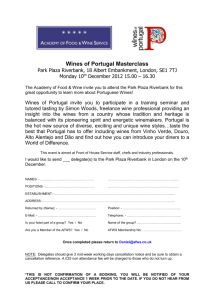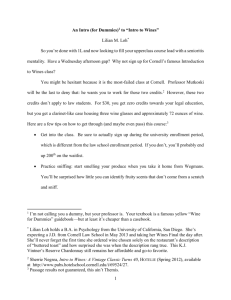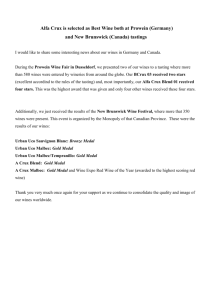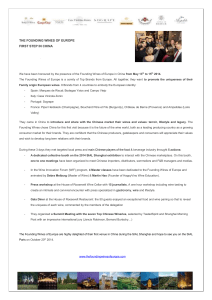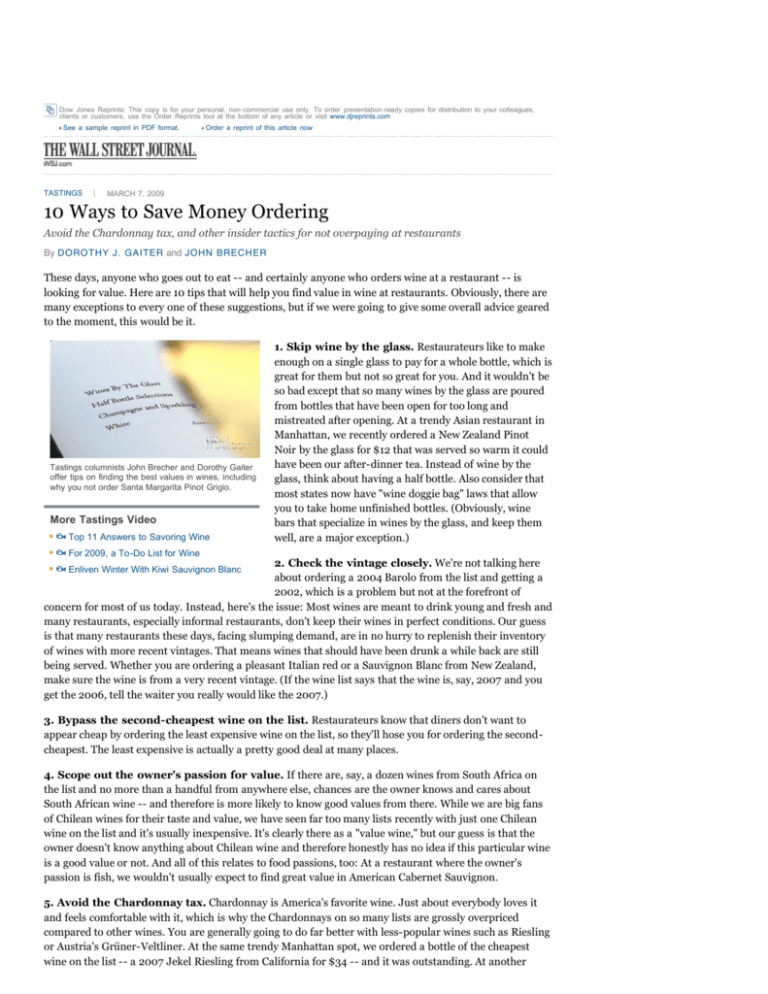
Dow Jones Reprints: This copy is for your personal, non -commercial use only. To order presentation-ready copies for distribution to your colleagues,
clients or customers, use the Order Reprints tool at the bottom of any article or visit www.djreprints.com
See a sample reprint in PDF format.
TASTINGS
Order a reprint of this article now
MARCH 7, 2009
10 Ways to Save Money Ordering
Avoid the Chardonnay tax, and other insider tactics for not overpaying at restaurants
By DOROTHY J. GAITER and JOHN BRECHER
These days, anyone who goes out to eat -- and certainly anyone who orders wine at a restaurant -- is
looking for value. Here are 10 tips that will help you find value in wine at restaurants. Obviously, there are
many exceptions to every one of these suggestions, but if we were going to give some overall advice geared
to the moment, this would be it.
Tastings columnists John Brecher and Dorothy Gaiter
offer tips on finding the best values in wines, including
why you not order Santa Margarita Pinot Grigio.
More Tastings Video
Top 11 Answers to Savoring Wine
1. Skip wine by the glass. Restaurateurs like to make
enough on a single glass to pay for a whole bottle, which is
great for them but not so great for you. And it wouldn't be
so bad except that so many wines by the glass are poured
from bottles that have been open for too long and
mistreated after opening. At a trendy Asian restaurant in
Manhattan, we recently ordered a New Zealand Pinot
Noir by the glass for $12 that was served so warm it could
have been our after-dinner tea. Instead of wine by the
glass, think about having a half bottle. Also consider that
most states now have "wine doggie bag" laws that allow
you to take home unfinished bottles. (Obviously, wine
bars that specialize in wines by the glass, and keep them
well, are a major exception.)
For 2009, a To-Do List for Wine
2. Check the vintage closely. We're not talking here
about ordering a 2004 Barolo from the list and getting a
2002, which is a problem but not at the forefront of
concern for most of us today. Instead, here's the issue: Most wines are meant to drink young and fresh and
many restaurants, especially informal restaurants, don't keep their wines in perfect conditions. Our guess
is that many restaurants these days, facing slumping demand, are in no hurry to replenish their inventory
of wines with more recent vintages. That means wines that should have been drunk a while back are still
being served. Whether you are ordering a pleasant Italian red or a Sauvignon Blanc from New Zealand,
make sure the wine is from a very recent vintage. (If the wine list says that the wine is, say, 2007 and you
get the 2006, tell the waiter you really would like the 2007.)
Enliven Winter With Kiwi Sauvignon Blanc
3. Bypass the second-cheapest wine on the list. Restaurateurs know that diners don't want to
appear cheap by ordering the least expensive wine on the list, so they'll hose you for ordering the secondcheapest. The least expensive is actually a pretty good deal at many places.
4. Scope out the owner's passion for value. If there are, say, a dozen wines from South Africa on
the list and no more than a handful from anywhere else, chances are the owner knows and cares about
South African wine -- and therefore is more likely to know good values from there. While we are big fans
of Chilean wines for their taste and value, we have seen far too many lists recently with just one Chilean
wine on the list and it's usually inexpensive. It's clearly there as a "value wine," but our guess is that the
owner doesn't know anything about Chilean wine and therefore honestly has no idea if this particular wine
is a good value or not. And all of this relates to food passions, too: At a restaurant where the owner's
passion is fish, we wouldn't usually expect to find great value in American Cabernet Sauvignon.
5. Avoid the Chardonnay tax. Chardonnay is America's favorite wine. Just about everybody loves it
and feels comfortable with it, which is why the Chardonnays on so many lists are grossly overpriced
compared to other wines. You are generally going to do far better with less-popular wines such as Riesling
or Austria's Grüner-Veltliner. At the same trendy Manhattan spot, we ordered a bottle of the cheapest
wine on the list -- a 2007 Jekel Riesling from California for $34 -- and it was outstanding. At another
restaurant recently, we had an excellent bottle of Domäne Wachau Grüner-Veltliner for $22. On the same
list, Beringer White Zinfandel was $20.
6. Never order Santa Margherita Pinot Grigio. We don't mean to pick on Santa Margherita. We
know many people like it and that's fine. But because so many people like it, it is routinely one of the most
outrageously priced wines on the list. We note it here only as a classic example of this: If you stay within
your comfort zone, ordering only wines you already know, you will be punished for it, price-wise. In
addition, no wine is going to seem like a good value to you when you know you could buy it at a local store
for half the price or less. That's why it's so important to focus on labels or kinds of wines that you wouldn't
otherwise see. At the same restaurant where we had that outstanding Grüner for $22, Santa Margherita
was $45. And we've seen it on other lists for $55. Remember: There is value in tasting something new.
7. Don't ignore house wines, by the bottle or in
carafes. People who travel around the world often tell us
they wish more American restaurants offered the simple,
inexpensive and delightful wines that seem ubiquitous in
Europe and elsewhere. We agree. But we do think we are
seeing a slight uptick in the number of restaurants in
America offering house wines -- especially at informal
places -- and, more often than not, we have found these
lusty and fun.
8. Look for half-price deals. If you missed the Wine
Events recently listing a few of the restaurants offering,
say, 50% off every bottle on Mondays, drop us a note and
we'll send it along. But that listing was just the tip of the
iceberg. This trend is sweeping the nation. Look around
James O'Brien
and you are likely to find a deal like that in your
neighborhood. Some places are even offering half price deals by region -- say, 50% off French wines one
week and Italian another week.
9. BYOB. Check around for restaurants that allow you to bring your own wine. And if there is a
restaurant you know well, ask if you could bring your own wine and pay corkage. Remember that the point
here isn't just to save money, but to have wines that the restaurant doesn't offer or that you might
otherwise postpone opening. More restaurants than ever, eager for business, are relaxing their rules on
BYOB and lowering corkage fees. Even some fancy places now are offering special BYOB nights.
10. Have it your way. No wine, at any price, is a good value if you don't enjoy it. Restaurants, now more
than ever, are eager for you to have a good experience so you will come back. Don't be shy. If you think the
red wine is too warm, ask for an ice bucket. If you want the waiters to stop pouring so much into your
glass, tell them -- nicely, of course. We are all in this economic mess together and everyone understands -or should understand -- that a night out these days needs to be relaxing and personal.
Sure, there are many other ways to find value on a list, but we have tried to focus here on simple stuff and
things we actually do ourselves. If you are willing to put some more work into this, one idea we'd suggest is
checking before you dine to see if a restaurant's wine list is online. This will give you more time to study
the list to find good values. And while personally we wouldn't do it, we know there are people out there
who enjoy bargaining and we'd guess that at least some restaurants would be willing to dicker on the price
of more-expensive wines these days. Finally, we understand that there are some restaurants where it's
simply impossible to get good value because the prices of their wines are uniformly ridiculous; those
restaurants do not deserve your business. Just remember that, in good times and bad, wine always tastes
better when it's a good deal.
***
Thanks to all of you who have already written to tell us about your extraordinary evenings on Open That
Bottle Night 10. There is still time to share your story. Drop us a note at wine@wsj.com. Be sure to include
your name, city and phone number.
Write to Dorothy J. Gaiter and John Brecher at wine@wsj.com
Printed in The Wall Street Journal, page W6
Copyright 2011 Dow Jones & Company, Inc. All Rights Reserved
This copy is for your personal, non-commercial use only. Distribution and use of this material are governed by our Subscriber
Agreement and by copyright law. For non-personal use or to order multiple copies, please contact Dow Jones Reprints at 1-800-8430008 or visit
www.djreprints.com


